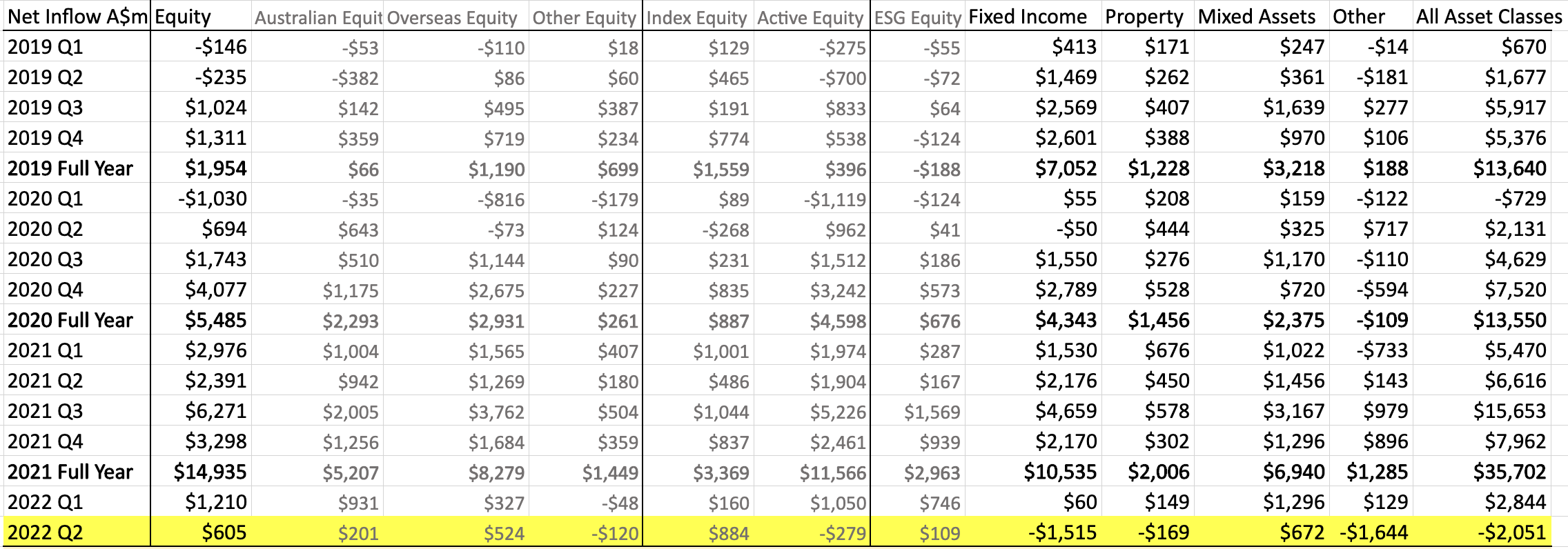Calastone: Investors cashed out $2 billion from managed funds in the June quarter
Technical analysts may say the trend is your friend. But in the case of 2022 so far, the trend has been anything but a friend for many investors. With so much bearish sentiment in the market, it's not just individual investors that have been stomaching losses.
A new report from global research house Calastone revealed that investors took out more than $2 billion from Australian managed funds last quarter. All but one of the sectors covered by Calastone recorded negative outflows. And perhaps most importantly, sentiment shifted dramatically.
This wire will take a top-down view of the statistics, and where we go from here. But first, here are some fast stats:
- $253m of outflows in June alone
- Flows were negative in every category except ASX stocks in June
- Q2 saw equity fund inflows fall to the lowest since Q1 2020
- Fixed income funds saw record outflows in Q2
- Across all asset classes, Q2 outflows of A$2.05 billion - the largest since records began

Reacting to the equity bear market
If Jerry Maguire said "show me the money", then it was Australian investors who collectively said, "take the money and run". In June alone, investors took out more than $250 million from Australian equity funds. The moves in one month nearly wiped out inflows for the entire quarter as fears of a recession and the realities of higher interest rates began to bite.
Overall, net inflows to Australian equity funds between April and June were the lowest since the onset of the pandemic in March 2020. The June quarterly print was also just one-quarter of the inflows seen this time last year and one-tenth the volume witnessed in the third quarter of 2021.
The falls are even more dramatic when inflows are segmented by style and strategy.
While index fund inflows last quarter were relatively similar to the figures seen at the end of last year, active strategies suffered significantly after eight straight quarters of outperformance. Thanks to a $300 million-plus outflow in June, active strategies recorded their first negative outflow quarter since the onset of the pandemic.
ESG equity inflows also recorded their worst quarter since mid-2020 with just $109 million coming into the coffers. It's certainly a long slide from the all-time peak in the September 2021 quarter when more than $1.5 billion in inflows were recorded in that space.
Is the housing bull market over?
Rising interest rates also took a big bite out of property funds. Be it commercial or residential, the housing market has certainly turned south. CoreLogic's home price index has shown prices in Sydney and Melbourne have decreased for two months. While other cities' prices continue to rise, the dominance of these two cities is such that their falls have sunk the national average.
Capital values are sensitive to rising interest
rates and a severe recession would inevitably lead to stress among commercial and residential tenants.
But in the funds management space, infrastructure and property as an asset class recorded its first negative flow quarter ever. There was nearly $170 million in withdrawals and the moves are also relatively unusual in comparison to other areas of the globe.
Perhaps that's a sign that the bigger the bubble, the faster it bursts.
Bonds, unwanted bonds
But if you thought property funds had an unprecedented quarter, spare a thought for fixed income fund managers. The trend of outflows that started in March accelerated each month through to June. Of the $1.5 billion in outflows seen last quarter in the fixed income funds space, almost two-thirds of it happened in June.
Calastone's research also suggests that the outflows stem from selling rather than a buyers' strike. This suggests investor sentiment was particularly poor in that asset class. The sentiment was backed up by research from Deutsche Bank, which suggested that US Treasuries had their worst quarter since 1861.
Fixed income also differs from property funds in that Australians were not out of step with their global comrades. Calastone’s analysis of global fund flows showed similar behaviour among those across Europe and Asia.
The outlook
The big question now is how markets and sentiment will develop from here. After last night's US inflation print came in at over 9%, investors will now turn their attention to whether the world's most important central bank could hike rates by a full percentage point at their next meeting. Global equities are already down hard with the MSCI World Index sitting near its 52-week lows, as of writing.
It all sets up for a very interesting second half - and investor sentiment will be crucial in determining how quickly (or slowly) people dip their toes back into risk assets.
Never miss an insight
If you're not an existing Livewire subscriber you can sign up to get free access to investment ideas and strategies from Australia's leading investors.
We're also going to be exploring how the different funds in Livewire's wheelhouse have performed over FY22. If you'd like to see who did what, and more importantly, how well they did, I encourage you to follow my colleagues:
- Ally Selby (alternatives)
- David Thornton (fixed income)
- Glenn Freeman (ASX shares)
- Sara Allen (global shares)
- James Marlay (property)
2 topics
5 contributors mentioned

